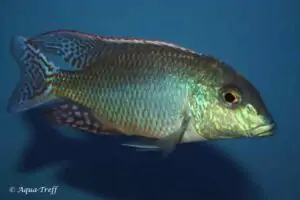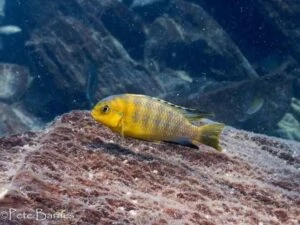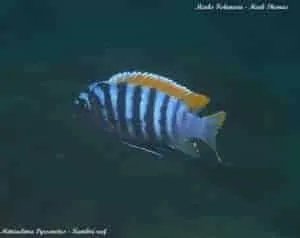Placidochromis sp. “Jalo”
Placidochromis sp. “Jalo” is a species not yet officially described. The genus name Placidochromis can be divided into two parts. “Placidus” means “quiet” or “calm”; a reference to the preference for calm water of most species within this genus. The second part is “chromis”. An ancient name for colourful cichlids, once thought to be related to the colourful damsels and wrasses of the sea. The placeholder “Jalo” is a reference to the location of Jalo Reef’s origin.
Previously, this was thought to be a variant of Otopharnyx heterodon. However, in morphology and behaviour they are much more similar to Plachidochromis sp. Blue Otter and are therefore classified in the Placidochromis genus.
Description
In the wild, the Placidochromis sp. “Jalo” males can reach a total length of about 12 centimetres. The females remain a bit smaller at 9 centimetres. They can grow a bit bigger in the aquarium. This is because we give them more and more powerful food than they get in nature.
An adult male in breeding dress has a brilliant metallic green colour. The body is dark blue with a number of black vertical stripes. The upper edge of the dorsal fin is trimmed with a number of thin lines, from the inside to the outside they are black, white, and yellow. The rear part of the dorsal fin, the caudal fin and the anal fin have yellow spots. The anal fin shows clear egg spots.
The females are not as beautifully coloured as the males. They are grey/brown in colour.
The juveniles have three black spots on their flanks, the first in the middle and the last on the caudal peduncle. These black spots disappear as they grow up, approximately when they reach a length of 5 centimetres.
Biotope
This species inhabits the transition zone from rocks to sand. Usually at a depth of 10 to 20 meters.
The distribution area is very small. They are only found around Jalo Reef.
This species resembles that of Placidochromis sp. “Blue Otter”, both feed on food particles in the sediment and are attracted to whirled-up dirt. The males are found in groups with the females while foraging, even males in breeding colour and females incubating. It is therefore suspected that this species is not territorial.
Diet
In Lake Malawi, they feed mainly by flushing sediment from the rocks and bottom through their gills.
It is an opportunistic eater that is attracted to swirling sand. They follow other, large, fish that look for their food in the sand. Placidochromis sp. “Jalo” makes good use of this by following them and also extracting food particles from the swirling sand.
In the aquarium, it is not a picky eater. Give them varied food, which can consist of, for example, live or frozen black and white mosquito larvae, artemia, daphnia, shrimp and mysis. Supplement this with spirulina flakes, flake food and granules.
The Aquarium
For a group of two males and four or five females, you need an aquarium of about 150 centimetres in length. Set up the aquarium with (filter) sand on the bottom. Build a few carefully stacked piles of rocks. In between, make holes, cracks and crevices. This way, the females can escape the attention of the males by hiding if they pursue them for too long.
Water parameters
You can maintain a temperature of about 22 to 26 degrees Celsius for the aquarium water. The pH is preferably between 7.5 and 8.5.
Breeding aquarium and conditioning
The breeding of Placidochromis sp. “Jalo” isn’t too difficult. Most Malawi cichlids are able to reproduce in a mixed aquarium. So you do not need a separate breeding aquarium. Just make sure that the aquarium is set up correctly. That is, with sand on the bottom and a few rocks so that the males can find a suitable place to spawn in the sand, next to a rock.
The spawn
The male makes a shallow pit in the sand near a rock. He tries to lure one of the females to his spawning pit. As soon as he notices that one of the females is ready to lay eggs, the mating dance begins. As soon as the female comes close to his chosen spot, he swims in front of her. He shows his most beautiful colours, flares his fins and with short trembling movements, he shows her how beautiful he is.
When the female is ready, she follows the male. They circle each other, just above the sand. After a while, the female lays a few eggs while they keep circling. The couple continues to circle with the male fertilizing the eggs and the female taking the eggs in her mouth.
Raising the fry
The female incubates the eggs in her mouth. An experienced female can lay about 40 to 50 eggs. Although the eggs hatch after a few days, the young still remain in her mouth. They then live on their egg yolk sac. Only three weeks after laying the eggs do the young fish leave their mother’s mouth.
In an aquarium with several adult cichlids, most of the young fish will be eaten. If you want to keep more fry, you can catch the female after about 15 days after spawning. Place her in an aquarium with approximately equivalent water values. Provide some sand on the bottom and a place where she can hide. As soon as she spits out the fry, she does not eat them immediately. Remove the female once she has released the fry and place her back in the tank.
You can feed the Placidochromis sp. “Jalo” fry with freshly hatched brine shrimp and crushed flake food. Apparently, the fry are more sensitive to fluctuations in water values than most Malawi cichlids. Change small amounts of water regularly. It also helps to ensure that no food is left behind. Feed them small amounts at a time and make sure all food is eaten.
Conclusion
Placidochromis sp. “Jalo” is a very nice Malawi cichlid. Keep them together with other calm and more peaceful species. Raising young fish is a bit more difficult, but with some attention to water quality, it is certainly doable.
Video
Author
John de Lange
Copyright images
Malawi’s Unlimited
Markus Bredehöft
References
NVCweb
Cicklid.org
Malawi Cichliden in hun natuurlijke omgeving 3e oplage – Ad Konings
Back to Nature – Malawi Cichliden – Ad Konings























Reviews
There are no reviews yet.